Singer Building II, Field Leiter & Co Building, Marshall Field Building
Life Span: 1879-1905
Location: Northeast Corner State and Washington Streets
Architect: James Van Dyke
Inter Ocean, December 29, 1877
THE SINGER BUILDING.
Plans for the Rebuilding of the Edifice Formerly Occupied by Field, Leiter & Co.
As announced some time ago in The Inter Ocean, the differences between the insurance companies and the Singer Company, in regard to the loss upon the building occupied by Field, Leiter & Co. up to the night of the fire, were settled for $85,000. This was considered far below the real damage, but the sacrifice was made by the Sirgen’s to save time and make certain changes In the plan of the edifice. It has been determined at length to begin the work of repairing the structure. The operations will probably be under way in a few days, provided a sudden change of weather does not cause delay. The building will be entirely taken down and the stories relaid, in order to make them completely fire-proof. A mansard roof is to be put upon it, making the edifice, altogether, seven stories in height. The old style of stand-pipes on the inside of the building will be abolished and hose attachment at each story. The girders of the entire building are to be of iron, and the elevators are to be bricked up from top to bottom. The fatal tank, whose fall caused such destruction at the last fire, will not be replaced. There is to be no area, as before, in the center of the building. but a light shaft similar to it is to be put in at the north end, to light that part of the store in case it should be divided. The improvements will cost, it is estimated, some $250,000, and will be completed by Aug. 1, 1878.
Chicago Tribune, January 17, 1878
THE SINGER BUILDING.
Operations to Begin.
Since Monday last Mr. George R. Mackenzie, Vice-president of the Singer Sewing-Machine Company, has been in this city looking after the rebuilding or selling of the remains and site of what was recently Field and Leiter’s retail establishment, at the northeast corner of State Washington streets. There have been negotiations for the sale of the property to Field, Leiter & Co., but it seems that no agreement could be reached, and this morning the rebuilding of structure will be commenced by the Singer Manufacturing Company, and a better and finer building will be put up than existed before, and one thoroughly fire-proof.
Chicago Tribune, November 3, 1878
The Singer Building.
As the Singer building approaches completion it shows itself to be the finest structure ever put up in this city, and is said to be the handsomest dry-goods store in the world. The stores of Paris, while more ornate, are not so large nor so well built. The cost of the new building, allowing the value of the brick and stone and iron saved from the fire, will be $500,000. This, of course, does not include the ground. The whole structure is absolutely fire-proof. The floors are of brick, laid in arches between iron joints. Over the brick there are layers of cement, felt, and cement, again, on which is laid the flooring of Georgia pine. All the openings in the floors for elevators, light shafts, etc., are so protected that any one floor may be flooded with water to the depth of several inches without spilling ove on the floors below. The roof, a most important point, and one too often the weakest in buildings that claim to be fire-proof, is built like the ceilings. except that, instead of the flooring of Georgia pine, there is on the top a pavement of brick. Wherever one steps on the roof his feet touch back. There is no fire trap in the Mansard roof. This is built of iron filled in with brick. All the iron columns are enveloped in circular fire-brick, between which and the iron an air-space of two inches has been left. Outside of the fire-brick, plaster is put on and molded in the style of fluted Corinthian pillars. Two noticeable differences between the former and present buildings are the addition of a story, and the removal of the skylight towards the north wall, where its light is needed most. The building is 150 feet on Washington by 160 on State, and stands 127 feet from the sidewalk to the top of the tower, six stories high. The interior is to be decorated and frescoed at a cost of $10,000.
Who are to be the tenants of this business palace? That is one of those things that no fellow can find out, because it has not yet been settled. Negotiations are in progress in two directions, both with Chicago dry-goods houses. The building will be finished by Jan. 1, and will then be occupied by whichever house can see the most money in it, and, probably, pay the most money for it.

Singer Building II
Chicago Tribune, November 28, 1878
The Singer Building, corner of State and Washington streets, is rapidly approaching completion, and, it is expected, will be ready for a tenant by Jan. 1. About all the carpentry work has been done, except putting in the floors, this being delayed until the plasterers are through. The latter are now busy, and have possession of the structure, only a few other mechanics being employed at odds and ends. Who will be the occupants is yet an open question. The impression still prevails that Field, Leiter & Co. are to be, and this impression is strengthened by the fact that members of that firm have looked into the build and examined its arrangements. But the question will perhaps not be answerable until the workmen begin to put in fixtures. These will belong to the tenant, and their character will be apt to betray at least the line of business, and, this known, it will be easy enough to find out who the parties are.
Chicago Tribune, March 1, 1879
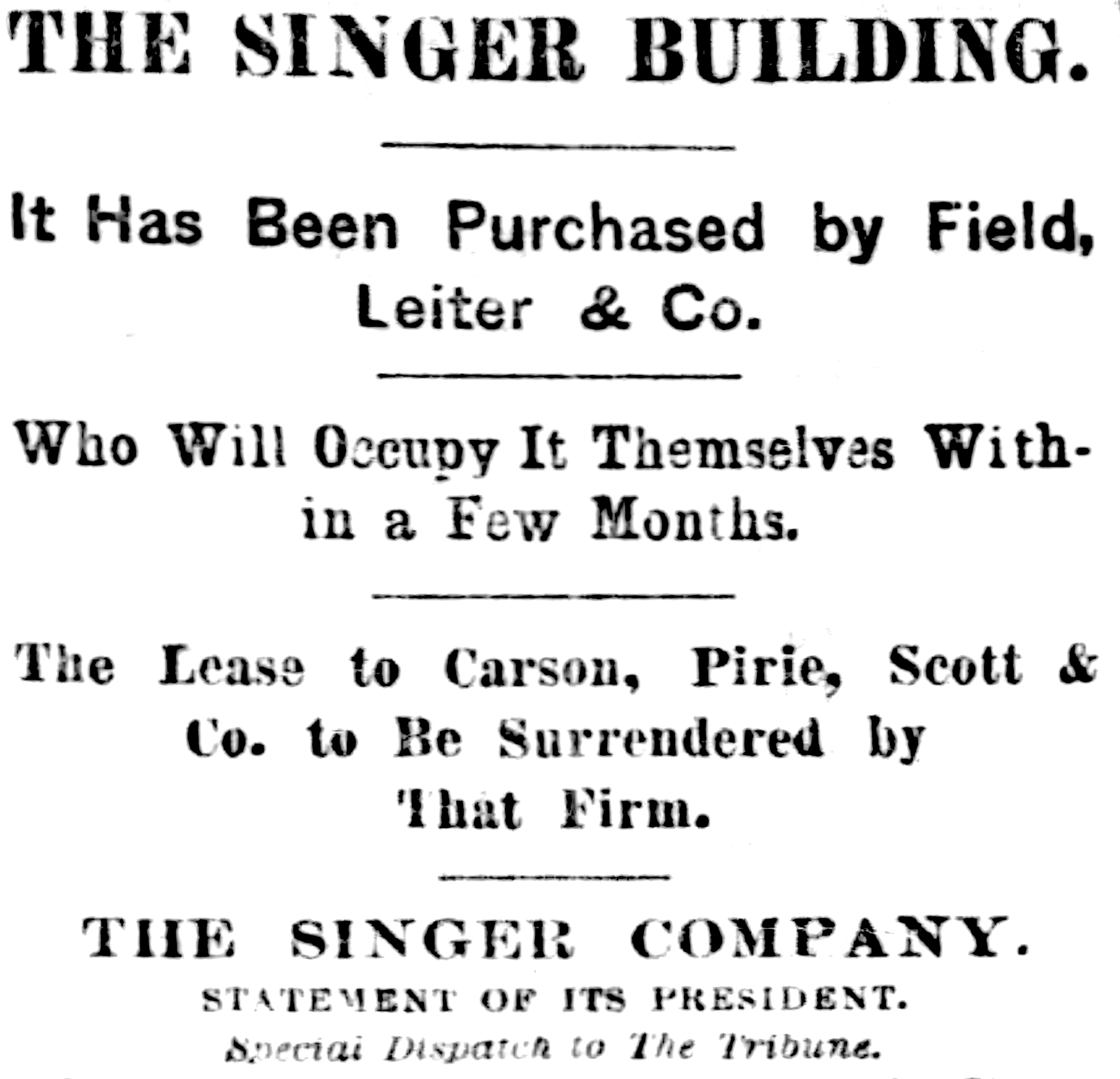 New York, Feb. 28.—The sale of the Singer Building, Chicago, to Field, Leiter & Co., was effected yesterday evening, and the latter firm take immediate possession of the property. The sum paid for it, as it stands, free from lease or incumbrance, was $750,000. Mr. Edward Clark, President of the Singer Manufacturing Company, said to your correspondent this evening that the Company was glad to dispose of the property this way, having previously offered to sell it to Field, Leiter & Co., who were in the best position to own it. “Immediately after the lease to Carson, Pirie, Scott & Co. had been recorded,” Mr. Clark continued, “and Field, Leiter & Co. were thus convinced of what they had not believed probably,—that the building was in reality rented,—the former tenants began negotiations to purchase.
New York, Feb. 28.—The sale of the Singer Building, Chicago, to Field, Leiter & Co., was effected yesterday evening, and the latter firm take immediate possession of the property. The sum paid for it, as it stands, free from lease or incumbrance, was $750,000. Mr. Edward Clark, President of the Singer Manufacturing Company, said to your correspondent this evening that the Company was glad to dispose of the property this way, having previously offered to sell it to Field, Leiter & Co., who were in the best position to own it. “Immediately after the lease to Carson, Pirie, Scott & Co. had been recorded,” Mr. Clark continued, “and Field, Leiter & Co. were thus convinced of what they had not believed probably,—that the building was in reality rented,—the former tenants began negotiations to purchase.
They sent W.H. Jing, an eminent lawyer and the counsel of the Singer Company in Chicago, to this city to see if terms could not be made. Field, Leiter & Co. offered to buy the building subject to the lease to Carson, Pirie Scott & Co., and wanted a price set upon it. A figure was named, and the firm replied they they would accept the offer provided the lease was removed. The Singer Company said this could be done, and Mr. King went back to Chicago, the offer being held open till he could consult with his clients.
The result of this consultation was, that Field, Leiter & Co. made a higher offer for the building than any amount named by the Singer Company, provided the lease could be removed. Finally, the firm telegraphed Mr. Clark to know on what terms they could be had free from the lease. After consulting with the parties here who controlled the matter yesterday morning, Mr. Clark replied by message that the sale could be completed for $750,000.
Last evening a dispatch was received from Field, Leiter & Co. accepting the terms, and closing the sale. The Singer Company hold that this sale puts Field, Leiter & Co. into possession of the finest and most complete store-building in the world. Thus the whole matter of the Singer Building is settled satisfactorily to all parties concerned, after months of negotiation.
Chicago Tribune, March 2, 1879
THE SINGER BUILDING.
History of the Negotiations.
A reporter received a full statement from a reliable source yesterday regarding the transaction in negotiating for the Singer Building. It has been the impression among the people at large that Field, Leiter & Co. paid the Singer Company a certain sum of money for the building clear of all incumbrances, and that, whatever the influence might have been to get Carson, Pirie, Scott & Co. to abandon their lease, the negotiations were conducted entirely between them and the original owners of the property.
Yesterday an interested party, in whom the writer has Do business to have anything but implicit confidence so far as his word goes, told him that the negotiations were carried on between the two dry goods firms, and that after repeatedly offering Carson, Pirie, Scott & Co. $50,000 to relinquish their lease, Field, Leiter & Co. offered them $100.000, the bargain was closed, and the check drawn by Marshall Field and placed in the hands of Mr. W. H. King, who deposited it to the credit of Carson, Pirie & Co. This was done Friday afternoon. Toward the last Field, Leiter & Co. became nervous, but the lessees of the building held firm and gained their point.
The informant further stated to the reporter that the negotiations of Carson, Pirie & Co. for the lease were all in good faith. They had money enough to swing in the new enterprise, and hod long felt a desire to get into same location on the South Side, They had waited for some time for Field & Leiter to go back into the building after the fire, but they had announced that they were well fixed where they were, and proposed to stay. The Singer agent had been repeatedly to Carson, Pirie & Co. to try to get them to take the lease, and finally they consented.
Last November, the building was offered to Field, Leiter & Co. for $600,000; they refused, and offered $500,000 for it. In January it was offered to them for $625,000, and again they refused. They have now paid for the building $650,000, and $100,000 to Carson, Pirie, Scott & Co. as a bonus, making the total cost $750,000.
The Inter Ocean, April 29, 1879
FIELD, LEITER & CO.’S OPENING.
The mammoth dry goods establishment of Field, Leiter & Co. has moved into its new quarters in the Singer Building, and yesterday the firm held its annual spring opening. There was a grand display of of goods and drapery, and the occasion was eagerly grasped by the lovers of “shopping” to make a day of it. The lower floor is taken up with general dry goods; the second with suits, clothes and worsteds, and the remaining three floors were reserved for manufacturing. The management of the opening was under the direct superintendency of Messrs. Fowler and Muir. M. Leiter being East. Mr. Field devoted a few moments of his time to the opening in the early part of the day.
Chicago Tribune, April 29, 1879
FIELD, LEITER & CO.
The New Store.
Field, Leiter & Co. have taken possession of their new store and began business in it yesterday. Crowds of ladies visited the place yesterday, and all appeared to be more delighted to think that the firm had gotten back to their new headquarters than were the proprietors themselves. The general expression upon meeting acquaintances connected with the store was “Home again, eh?” accompanied by congratulations.
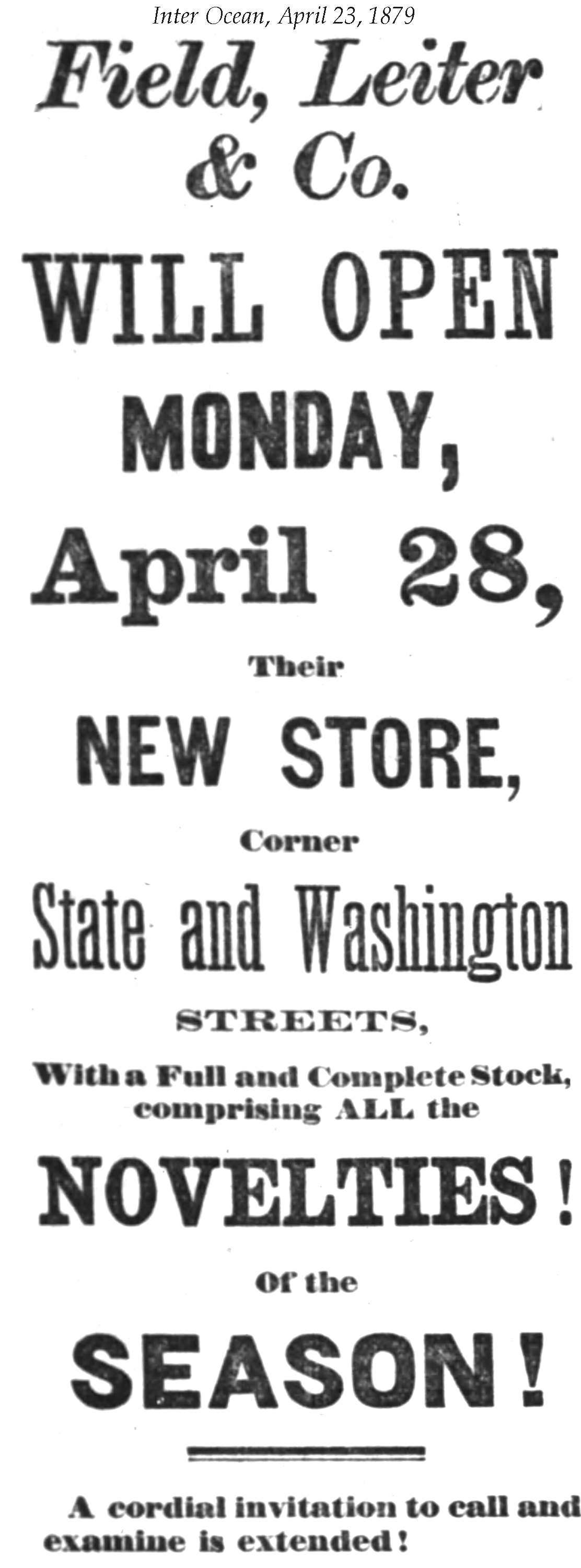
The general appearance of the store is much the same as was that of the old building, except that many improvements have been made. In the former store there were two staircases leading to the upper portion of the building, one on either side; now, instead of these, there is one grand staircase, twenty-three feet wide, in the centre, leading to a broad, half-way landing, capable of bearing up a weight of 75,000 pounds.
The first floor is devoted entirely general merchandise. Coming in at the State-street entrance a broad aisle will be found, leading back to the grand staircase in the rear. In this aisle fine fabrics, dress goods, displayed. The next gloves, etc., and flannels; the next section south is devoted to to embroideries, laces, etc.; and upon the extreme right, which is the lightest place in the store, may be found silks and hosiery exclusively. On the left of the main entrance are displayed fine velvets, ribbons, fans, and linens; the next section north is devoted to trimmings and notions, while gents’ furnishing goods occupy the extreme left of the building. The entire length of the building under the staircase is taken up by the examining and cash department.
Upon the second floor one will find on the right-hand of the staircase the home art department, devoted to fancy, ornamental decorations for homes, in worsted, silk, and embroidery. Directly at the left of the staircase is the general bookkeepers’ office, in front of which are the ladies’ and children’s furnishing goods, occupying one-fourth of the entire floor. Adjoining is the men’s cloth department. The first department in the southwest corner os that of the black goods, and outside of this the entire west front is occupied by ladies’ costumes, wraps, shawls, etc., the articles in question varying in price from 50 cents to $3,000 each. The floor of this department is carpeted. The extreme northeast corner is occupied by the skirt and corset department.
An interesting feature is the method of calling cash-boys. There is an entire absence of pounding upon counters with pencils or calling to them verbally, but the utmost silence prevails except the low conversations. The means employed is electricity. There is a sort of depot, where the boys remain until called for, and an enunciator, attended by one of the lads, indicates which counter is in need of “cash,” when the boy in charge sends one. This department was not in smooth running order yesterday, but Mr. Fleming, the Superintendent, explained that this was the first experience the boys had had, and they had nor quite learned the numbers of the counters.
The third floor is occupied entirely by carpets and upholstery. The fourth floor is the work-shop for carpets and upholstery. The fifth floor is given up to dress-making exclusively, there being some 300 women employed here. and on the sixth floor may be found the cloak, fur, and lace factory, where these articles are made up.
The southwest quarter of the basement is used as as a salesroom for domestic goods, and the remainder is used for storage and reserved goods.
The industrious Scotchmen from Amboy, Illinois who headed the firm of Carson, Pirie and Company signed a lease. Field was in New York during this time, but returned in time to thwart the plan. He upbraided Leiter for not carrying through the plan for moving back to State Street. At the conclusion of the fuss and fury, Field and Leiter got the store, but they had to pay not only the $700,000, the Singer officials asked for, but an additional bonus of $100,000 to Carson and Pirie to give up their lease.
By April, 1879, customers were lining up to another Field and Leiter State Street store. Two years later, Marshall Field bought out Levi Leiter and the first Marshall Field and Company store was christened.
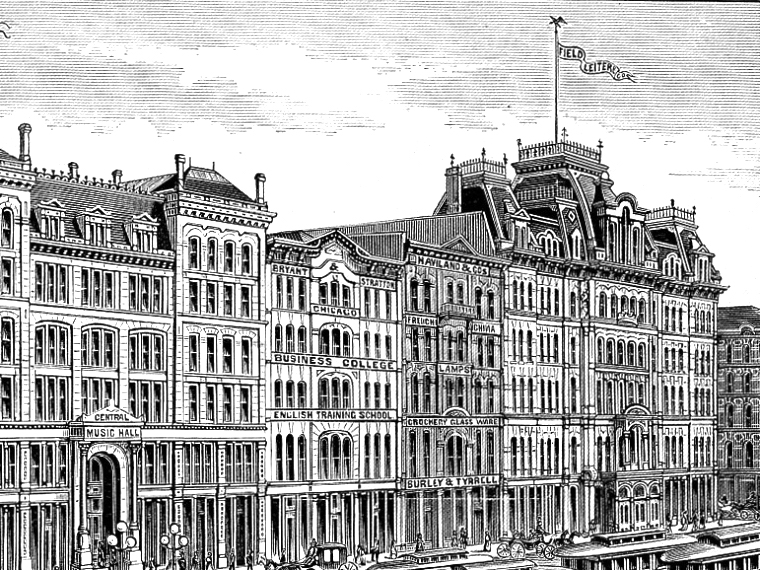
State Street
About 1880
Chicago Tribune, January 27, 1881
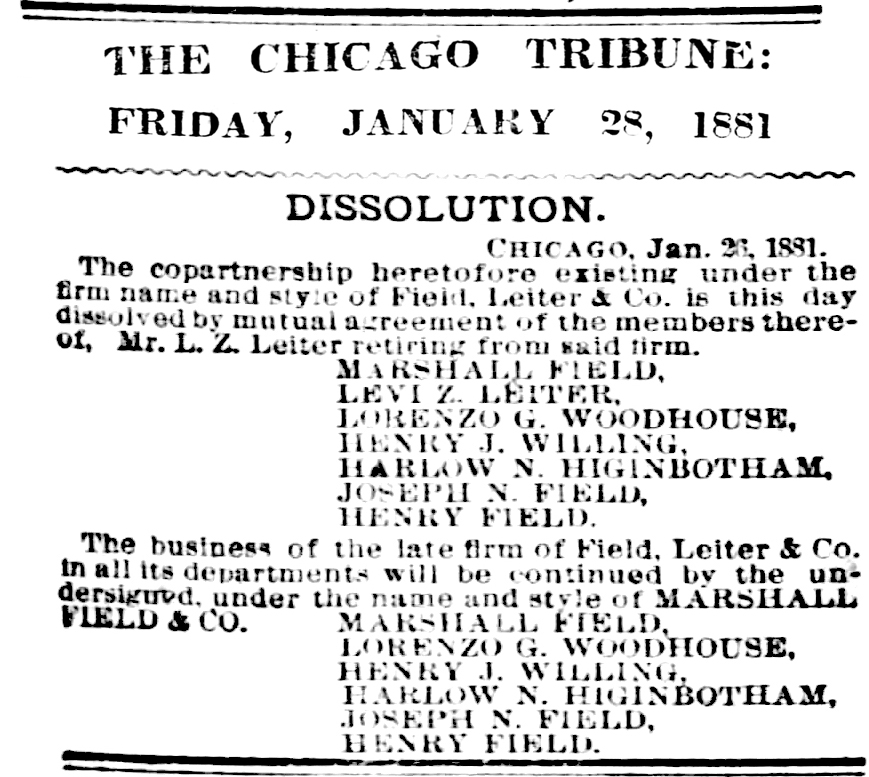 Such an idea as the dissolution of the firm of Field, Leiter & Co. probably never entered the brain of the average Chicagoan until it was fait accompli yesterday afternoon, because their retail goods palace on State street, their immense wholesale store on Madison street, and their extensive stables and warehouse accommodations wee marks, ever before the eyes of the public, of solidity, stability, and performance. Nor will any of these things be affected by the change in the firm, for the entire business in all its branches and details will be carried on exactly as before, except, perchance, the new firm will endeavor to surpass the old one, if it be possible, in building up the metropolis of the Northwest. In another way, the change may prove an incalculable benefit to Chicago, because the withdrawal of Mr. Levi Z. Leiter from active business in the dry goods line, he will have leisure to turn his attention to other branches of business, which will be stimulated by his capital, untiring energy, and business sagacity and experience, while the dry goods business will continue to prosper and extend under the control and guidance of the remaining members of the late firm of Field, Leiter & Co.
Such an idea as the dissolution of the firm of Field, Leiter & Co. probably never entered the brain of the average Chicagoan until it was fait accompli yesterday afternoon, because their retail goods palace on State street, their immense wholesale store on Madison street, and their extensive stables and warehouse accommodations wee marks, ever before the eyes of the public, of solidity, stability, and performance. Nor will any of these things be affected by the change in the firm, for the entire business in all its branches and details will be carried on exactly as before, except, perchance, the new firm will endeavor to surpass the old one, if it be possible, in building up the metropolis of the Northwest. In another way, the change may prove an incalculable benefit to Chicago, because the withdrawal of Mr. Levi Z. Leiter from active business in the dry goods line, he will have leisure to turn his attention to other branches of business, which will be stimulated by his capital, untiring energy, and business sagacity and experience, while the dry goods business will continue to prosper and extend under the control and guidance of the remaining members of the late firm of Field, Leiter & Co.
L.Z. Leiter and Marshall Field commenced their business lives in Chicago, with the firm of Cooley, Wadsworth & Co., or rather its successors, Cooley, Farwell & Co., of which firm L.Z. Leiter was head book-keeper, or office manager, while Marshall Field was the superintendent of the merchandise department, Cooley, Farwell & Co. were succeeded by John V. Farwell, Marshall Field, and Levi Z. Leiter, under the firm name of Farwell, Field & Co. Soon Messrs. Field and Leiter withdrew from this firm and formed another copartnership with Mr. Wilton Palmer, under the firm name of Field, Palmer & Leiter. Mr. Palmer withdrew from the business, and the firm of Field, Leiter & Co. was formed, with the following as partners:
Marshall Field, Levi Z. Leiter, Lorenzo G. Woodhouse, Henry J. Willing, Joseph N. Field, and Henry Field. About three years ago Mr. Harlow N. Higinbotham was admitted to a partnership.
On 1861 Messrs. Field and Leiter were clerks in the house of Cooley, Farwell & Co. Yesterday, scarcely twenty years after, they were the senior partners in in one of the largest and most prosperous dry goods houses in the world, and one of the two retires from the active prosecution of business with millions which he can call his own. The name Field, Leiter & Co. has been a synonym for push, purpose, grit, straightforward dealing, and general mercantile honor for nearly twenty years, and almost unparalleled success has attended it. With such a prestige, Marshall Field & Co. cannot fail to continue to advance toward the position of the leading dry goods house in the United States.
Inter Ocean, October 27, 1888
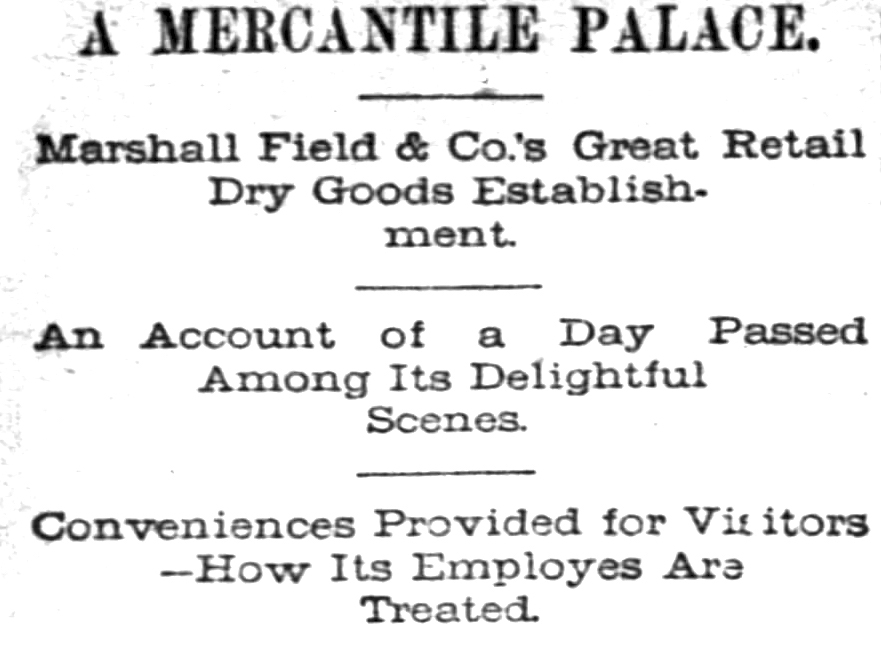 At Marshall Field & Co.’s one day the writer lingered, says the current Interior, in the retail establishment of what is in many respects, the greatest dry goods house earth ever produced. Deep and vivid were the impressions made. And with the help of the artists and with the kindly co-operation of Messrs. Marshall Field & Co., the result is here shown of an effort to portray the busy scenes.
At Marshall Field & Co.’s one day the writer lingered, says the current Interior, in the retail establishment of what is in many respects, the greatest dry goods house earth ever produced. Deep and vivid were the impressions made. And with the help of the artists and with the kindly co-operation of Messrs. Marshall Field & Co., the result is here shown of an effort to portray the busy scenes.
The exterior view will be recognized by thousands. The location, State and Washington streets, was first occupied by the house in 1868, having moved from Lake street, between Dearborn and Clark This move, more than any other one event, settled the character of State street as the Broadway of the Western New York. The building as occupied to-day embraces the Nos. 79, 81, 83, 85, 87, 89, 91, 93 and 95 on State street to the corner of Washington street, and east on Washington to the alley. The frontage is 260 feet on State and 150 feet on Washington.
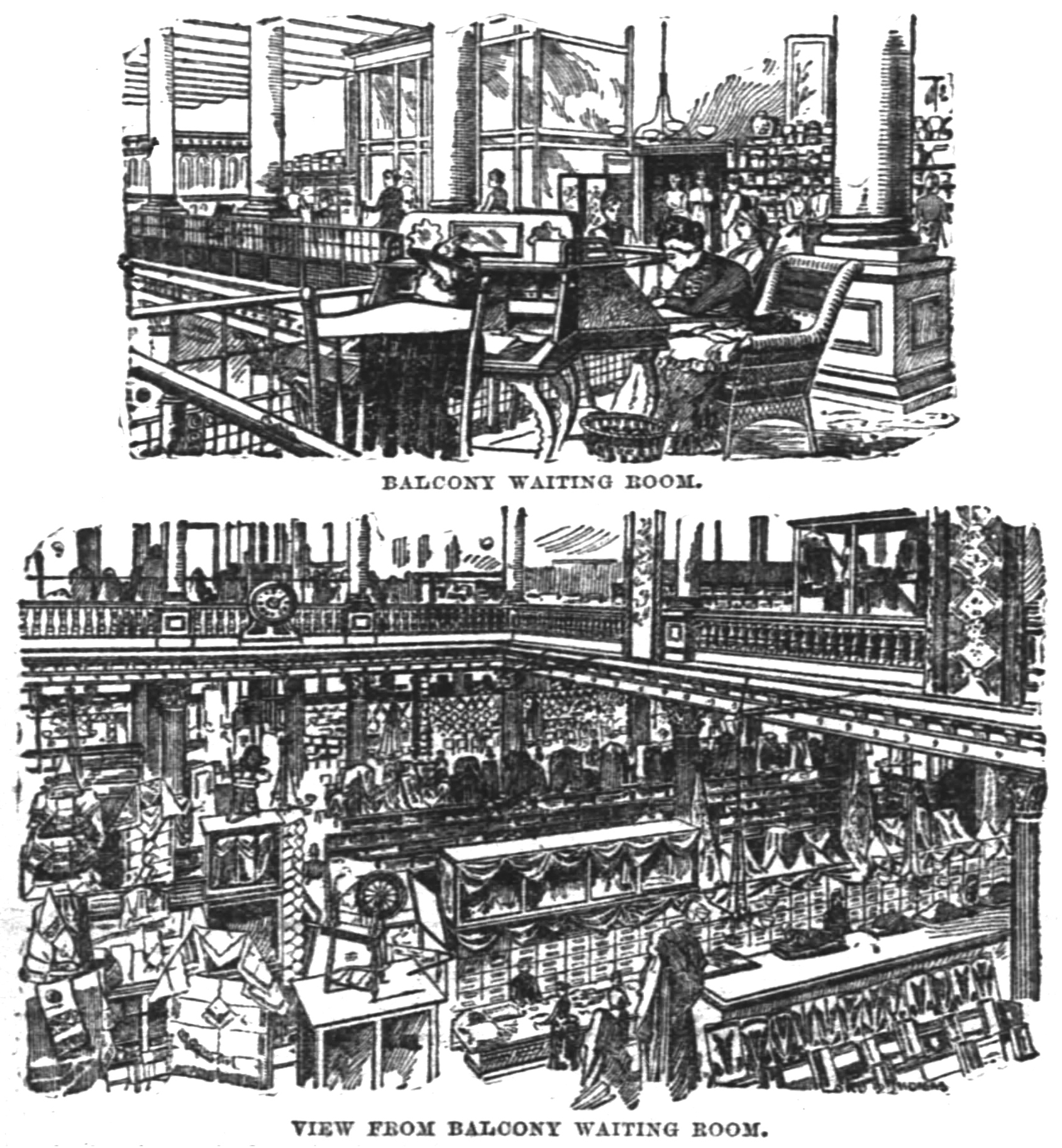
The present building is the third, the two preceding ones having been burned, the first in the great fire of 1871, and the second in 1877. Both fires tested and both exhibited the great reserve forces of the house. In sixteen days after the first when Chicago was prostrate in ashes, the store was re-opened at the corner of State and Twentieth streets, two or three miles south, in a large street car barn, until the building could be replace]. It was found necessary at this time to open a second temporary store on Madison street. Between the first and second fires occurred the alarm of 1874 that throughout rare executive ability. Not caring to risk the danger, the entire stock was packed and carted to the west side of the river in the night. At 6. a m. the drays wore headed back. At 2 o’clock the doors were open for trade as usual. In 1877 the second destruction by fire occurred. The majority of our senders may remember how the Exposition Building was used as a temporary home, succeeded by quarters on Wabash avenue, until the present building was ready.
Great as the house was in those days it had but really entered on its career of expansion, as the last decade has shown. Storeroom after storeroom on the north has been absorbed, the largest acquisition of space—a nearly fifty per cent increase—having been secured during the current year. Here, under one roof are more than seventeen hundred and fifty employes, an army of about two regiments of soldiers. The floor space is six acres, a mart prepared to meet the wants of ten thousand patrons at one time, or such a throng as would fill every pew in twenty churches of usual size, or overtax the capacity of half a dozen of the greatest hotels in the world, or fill sixteen passenger trains with eight coaches in each train. The interior is a very busy hive. The word hive suggests the hum of bees, not unlike the suppressed sound of voices and of hurrying feet coming from every quarter at once, above, below, before, behind—a one sits in the new balcony waiting-room on the second floor at the north end of the rotunda, shown in the picture. Carved oaken desks and chairs with writing materials are provided, telegraph blanks are at hand and telephones are conveniently near, all expressly arranged for the convenience of patrons and guests. The stationery is delicately engraved:
To the rear of the balcony are seen in the picture three new elevators, while the original three near the Washington street entrance are also retained. The view from the balcony waiting-room, as shown in the accompanying sketch, in a view of the main floor that will be recognized by many.

Not so familiar, but more interesting, perhaps, because now, are the sketches of the general office on the second floor, and the view from the fur and millinery departments looking toward the entrance and revealing just a glimpse of the new ladies’ retiring-room, pronounced unequaled in all respects for elaborate elegance and cleanliness. The closets are marble, and the floor is tiled. Mirrors and other appointments are of corresponding character, and individual towels are prepared for each lady’s use.
With the present enlarged space the stocks of dry goods, carpets, upholstery, millinery, furs. Oriental, and Japanese goods have been increased so that the largest stocks in the market are carried in most lines.
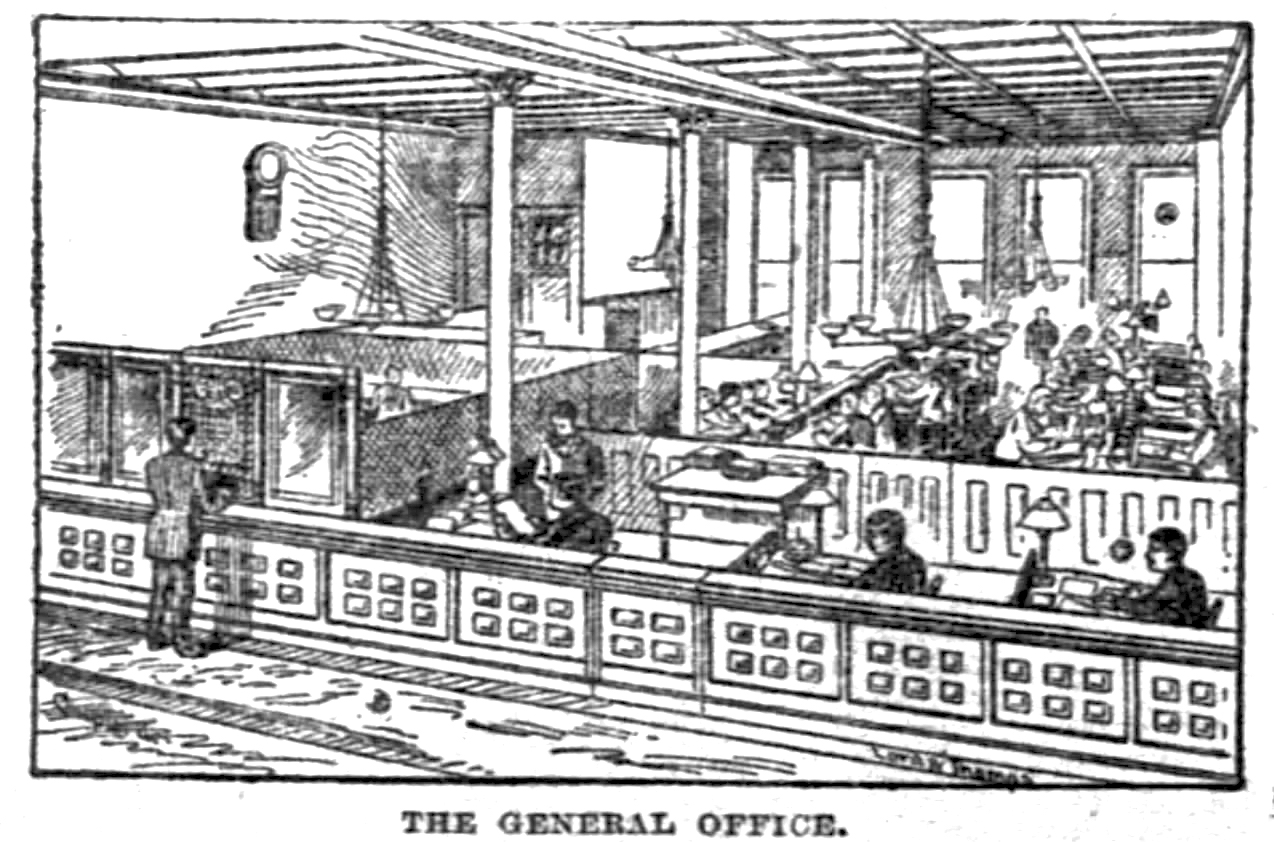
One of the most vital of more recent advances was the surrender of the basement floor entirely to lower priced goods. Shoddy excepted, all the lower priced goods in the market are here shown up to certain higher patron desiring to select finer and more costly goods in the same line looks for them on the floors above, or if she be on the main and upper floors and desires substantial goods but of less value than shown above she may proceed to the basement floor and find what she wants.
The writer spent last Wednesday in the store, privileged to go where he would. From the opening hour at 8 to the closing hour at 5:30 o’clock, the foundation principles of honesty and courtesy were apparent on every hand. Shoppers were met in the spirit of courtesy and treated generously, in a thousand different ways. The house concedes that error is possible and gracefully rectifies it. The confidence of the public that Marshall Field & Co. will do what is right in all matters—a feeling based on long experience—is the basis of a business vast beyond ail precedent. Mothers come with danghters about entering society, who themselves have been since girlhood the patrons of the house, and selected their wedding outfits there. Likewise there are many employes whose services range over long years up to a quarter of a century.
Many employes were asked to state why they preferred to work for Marshall Field & Co. The replies ware usually too personal, some of them too sacred to go into print. But one could not but conclude that Marshall Field & Co. has not only head. but heart—heart to sympathize and heart to help in distress, that awakens hearty respect for the house and pride in its never equaled success. A. T. Stewart & Co. ruled their business with a discipline of severity and fear; a greater house bas demonstrated how better a numerous force may be inspired to nobler exertion by justice and humanity.
The reader may be ready to ask who constitute Marshall Field & Co. The writer does not know the house personally. But stop. This statement is not strictly true. For that cash boy who talked bravely of his anticipated rise is Marshall Field & Co, full of hope. That girl who declared she enjoyed and preferred her work basting carpet seams ready for the sewing machine, was Marshall Field & Co., happy and faithful. That young man who said he appreciated his place because he was given individuality and scope to do his best was Marshall Field & Co., ambitious and eager. That middle-aged man who sold dress goods and liked the house because it only expected what was right, and appreciated it, was Marshall Field & Co, just and modest That veteran on the main floor who said that for twenty years he had been with the house and remarked that the firm was always “sticking to business” to the exclusion of speculation and all side issues was Marshall Field & Co., persistent and concentrated in effort. Those managers of the retail house going quietly through and about, masters yet servants to employes and patrons alike, avoiding personal notoriety, yet glorying in the enlarging prosperity of the house, are Marshall Field & Co., retiring as to personality, proud in present accomplishment, and planning largest things for the future.
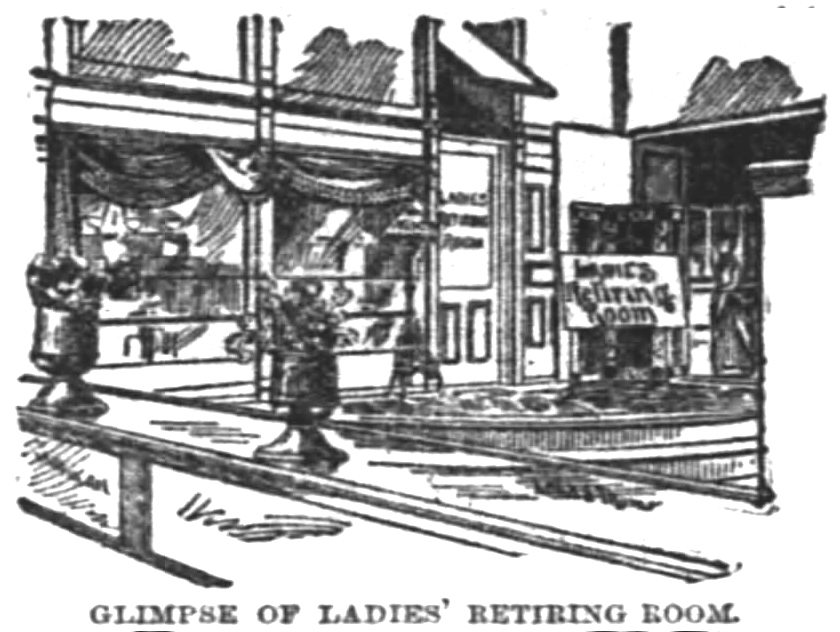
And with these enthusiastic forces continually strengthened by contact and counsel with the vigorous head of tho house, with a market known to be largely undeveloped, and in the light of the past the largest hopes appear reasonable, the greatest dreams expected realities.
The establishment and successful conduct of a great business like that of Marshall Field & Co. is a telling argument for clean methods in business. There is the fact of towering success which can not be gainsaid. There is no resisting its conclusions. There is the living illustration of integrity allied with success. It is a great sermon that especially may read with profit. Fair methods, so-called old-fashioned honesty, is as fashionable to-day, as successful to-day, as much appreciated to-day as at any time bear or remote in the world’s history. And honesty, instead of retarding, in fact promotes and accelerates the progress of true enterprise and real capacity for affairs.
The truth is that on account of the tremendous expanse of trade in these times commerce rests much more largely than ever on confidence, a confidence that can only be inspired and maintained when integrity is married to enterprise.
Chicago Tribune, December 28, 1890
MARSHALL FIELD’S BAY WINDOWS.
Manager Selfridge Says No Official Notice Has Been Given for Their Removal.
Henry Selfridge, manager of Marshall Field & Co.’s retail establishment, said yesterday that the firm had received no official notice of the action of the Council Committee on Streets and Alleys South, which declared Friday that the bay windows in the State street front of the big dry-goods store would have to go. Mr. Selfridge said:
- The windows were built under authority of the city, and with the full knowledge and consent of building inspectors and other proper officials. We have really given the city two feet more of sidewalk by removing the elevated prismatic lights which formerly ran the entire length of the building. People could not walk on the elevated portion of the walk, but when we made our improvements we leveled it and made the pavement broader by from two to five feet. I can hardly believe the Council will order us to make a change. If they do then we will see about taking the necessary steps to protect ourselves. I do not believe there have been any complaints against our building. I know of no reason why objection should have been raised by the committee.
Rand McNally Bird’s Eye Views of Chicago, 1893
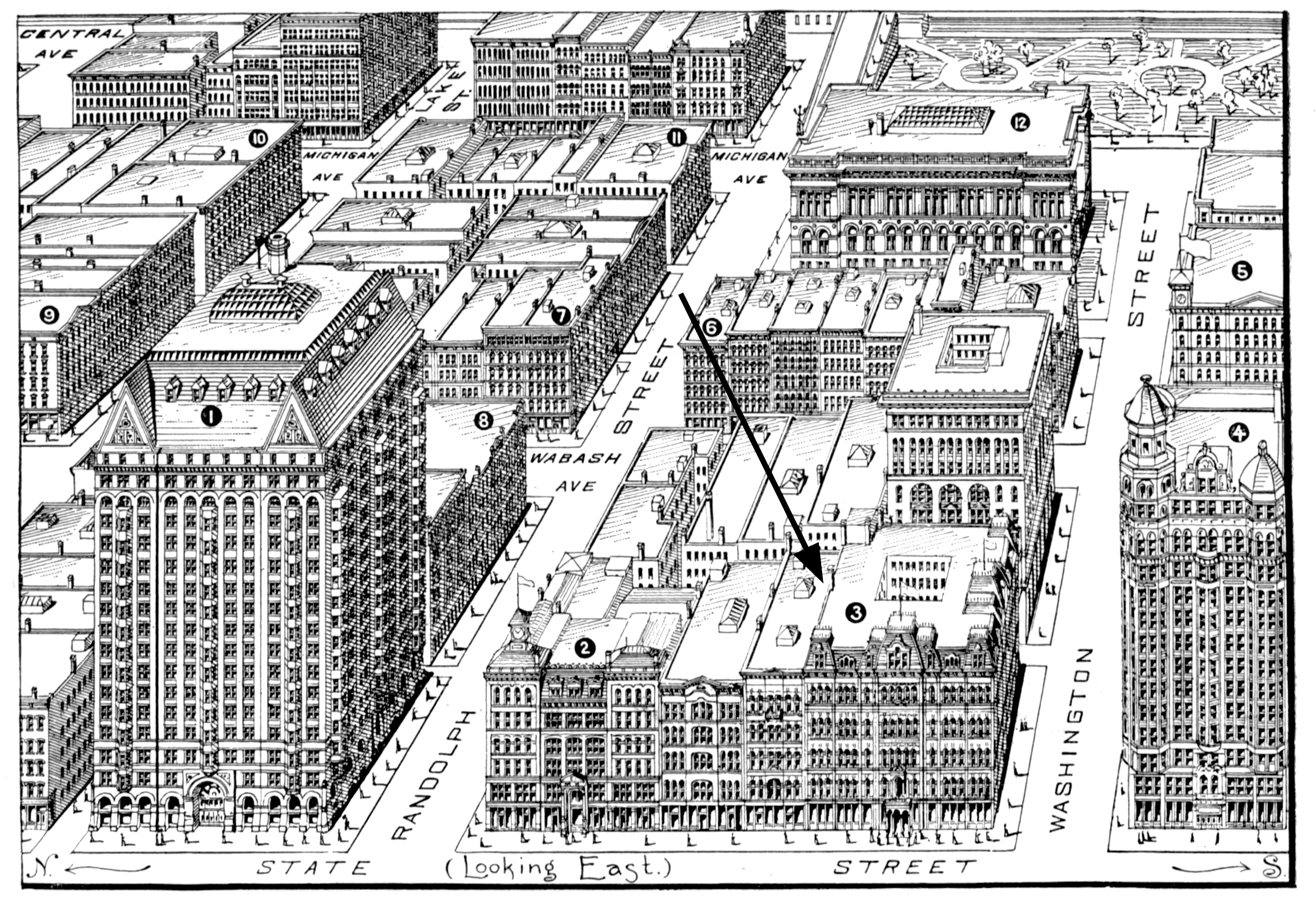
③ The Marshall Field Buildings
Occupy the whole north side of Washington Street, between State Street and Wabash Avenue, fronting 260 feet on State Street, 340 feet on Washington Street, 108 feet on Wabash Avenue. The old building is a remarkably handsome structure of the Parisian style, which is the third of a like appearance that has risen on this site since 1868, when it was first opened by this firm. It is 125 feet high, with 6 stories and basement, ornate stone front, and many pavilions. There are 6 elevators. The windows are dressed with the latest, richest, and most beautiful goods, and the interior presents an animated and enter- taining spectacle. The new building was erected in 1892, at the northwest corner of Washington Street and Wabash Avenue, of steel, granite, terra cotta, tile, and marble, in the latest style of fire-proof construction. It has 9 stories, 90 suites of offices, and no less than 13 elevators. The four lower floors have been added to the retail quarters, and the whole gives to Field & Co. a vast accommodation for their retail dry-goods business.
Inter Ocean, June 5, 1898
It is a dull week that does not develop news of some State street improvement. Following the announcement of Mandel Bros.’ acquisition of the northeast corner of Madison street, with the consequent remodeling and alteration, came the news that Schlesinger & Mayer are to erect a marble and bronze store building on the opposite corner. Now it is Marshall Field & Co.’s turn. The mansard of their store at State and Washington streets is to be removed and two additional stories are to be added, making a total of eight. At the same time interior alterations and repairs are to be made. In all $130,000 will be expended. The plans have been drawn by D. H. Burnham & Co. The dimensions of the building to be improved are 160 feet on State by 150 feet on Washington street. The structure as it stands is one of the most attractive of the commercial buildings of Chicago. It is to gain additional space and at the same time to improve the sky line that the change is to be made. Dankmar Adler has been engaged by Schlesinger & Mayer to design the power-house to be erected in connection with their new building, referred to above, the architect being Louis H. Sullivan. This brings the partners of the old-time firm of Adler & Sullivan close together once more.
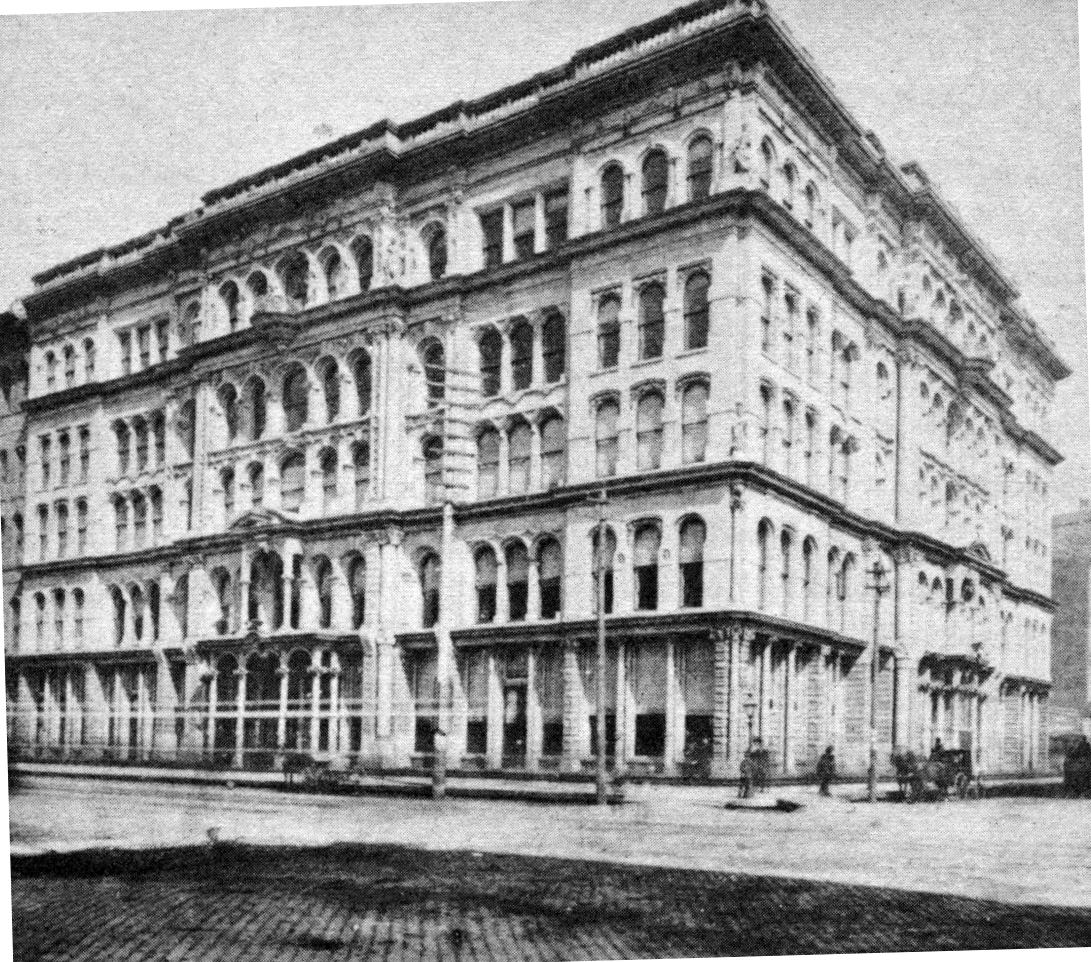
Singer Building II
1898.
THE STORY OF THE CLOCK.
Chicago Tribune, November 24, 1897
 Commissioner McGann has called the attention of the Law department to the complaint filed in his office by Alderman Coughlin against the large clock being erected in front of Marshall Field & Co.’s store at State and Washington streets. Commissioner McGann requests the Law department to supply him with an opinion as to whether or not there is anything in the city ordinances forbidding the hanging of a heavy iron clock from the second story of a building. The clock which is causing the trouble is a large iron one, weighing about 500 pounds. It extends over the sidewalk about nine feet.
Commissioner McGann has called the attention of the Law department to the complaint filed in his office by Alderman Coughlin against the large clock being erected in front of Marshall Field & Co.’s store at State and Washington streets. Commissioner McGann requests the Law department to supply him with an opinion as to whether or not there is anything in the city ordinances forbidding the hanging of a heavy iron clock from the second story of a building. The clock which is causing the trouble is a large iron one, weighing about 500 pounds. It extends over the sidewalk about nine feet.

The original clock as shown in 1904 on the Singer Building II (1878-1905).
Chicago Tribune, November 24, 1897
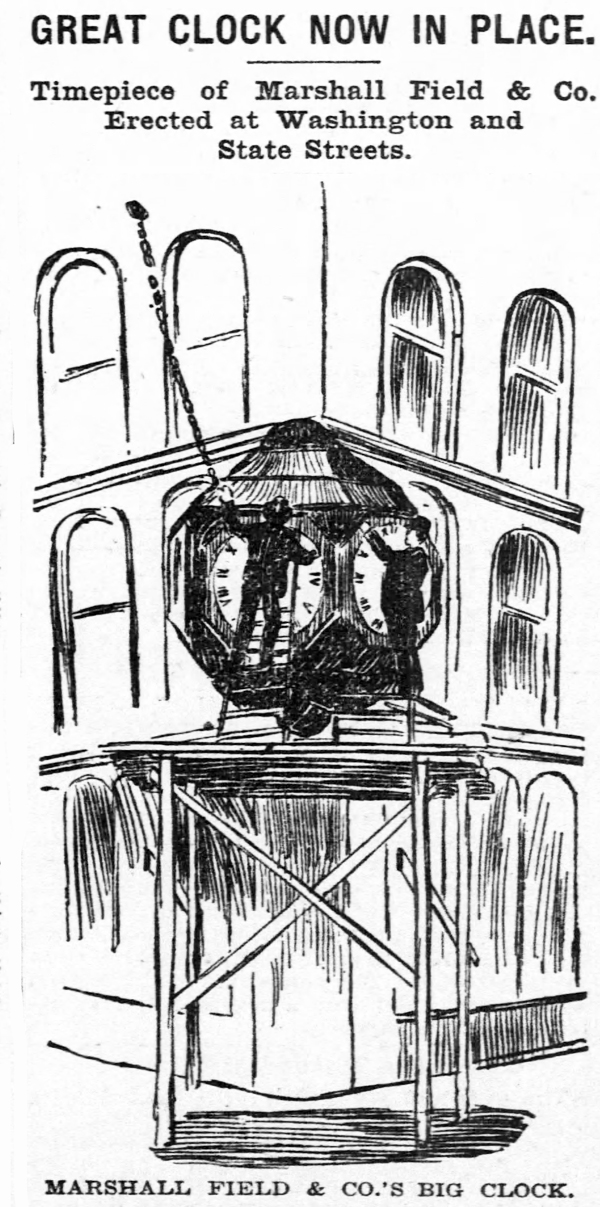 Commissioner McGann has called the attention of the Law department to the complaint filed in his office by Alderman Coughlin against the large clock being erected in front of Marshall Field & Co.’s store at State and Washington streets. Commissioner McGann requests the Law department to supply him with an opinion as to whether or not there is anything in the city ordinances forbidding the hanging of a heavy iron clock from the second story of a building. The clock which is causing the trouble is a large iron one, weighing about 500 pounds. It extends over the sidewalk about nine feet.
Commissioner McGann has called the attention of the Law department to the complaint filed in his office by Alderman Coughlin against the large clock being erected in front of Marshall Field & Co.’s store at State and Washington streets. Commissioner McGann requests the Law department to supply him with an opinion as to whether or not there is anything in the city ordinances forbidding the hanging of a heavy iron clock from the second story of a building. The clock which is causing the trouble is a large iron one, weighing about 500 pounds. It extends over the sidewalk about nine feet.
Chicago Tribune, November 26, 1897
The immense clock, with four great dials, which has been erected at the corner of Marshall Field & Co.’s building at Washington and State streets is attracting much attention. It is almost cubical and is hung from the cornice at the second story by ornamental iron work. Projecting as it does, several feet clear of the building, it will be very conspicuous, especially at night when it is lighted from within. There is no scarcity of timekeepers along the busy thoroughfare.
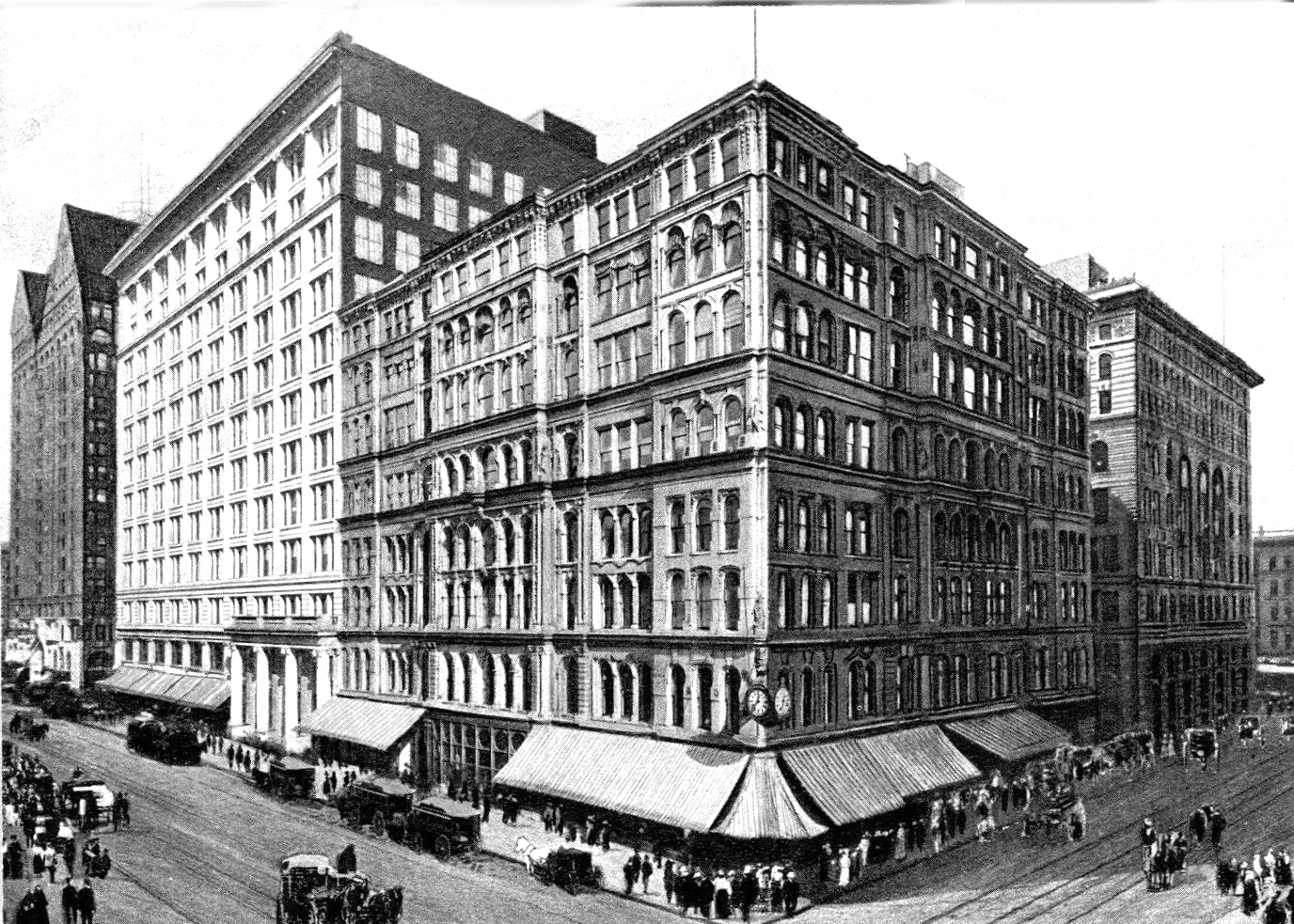
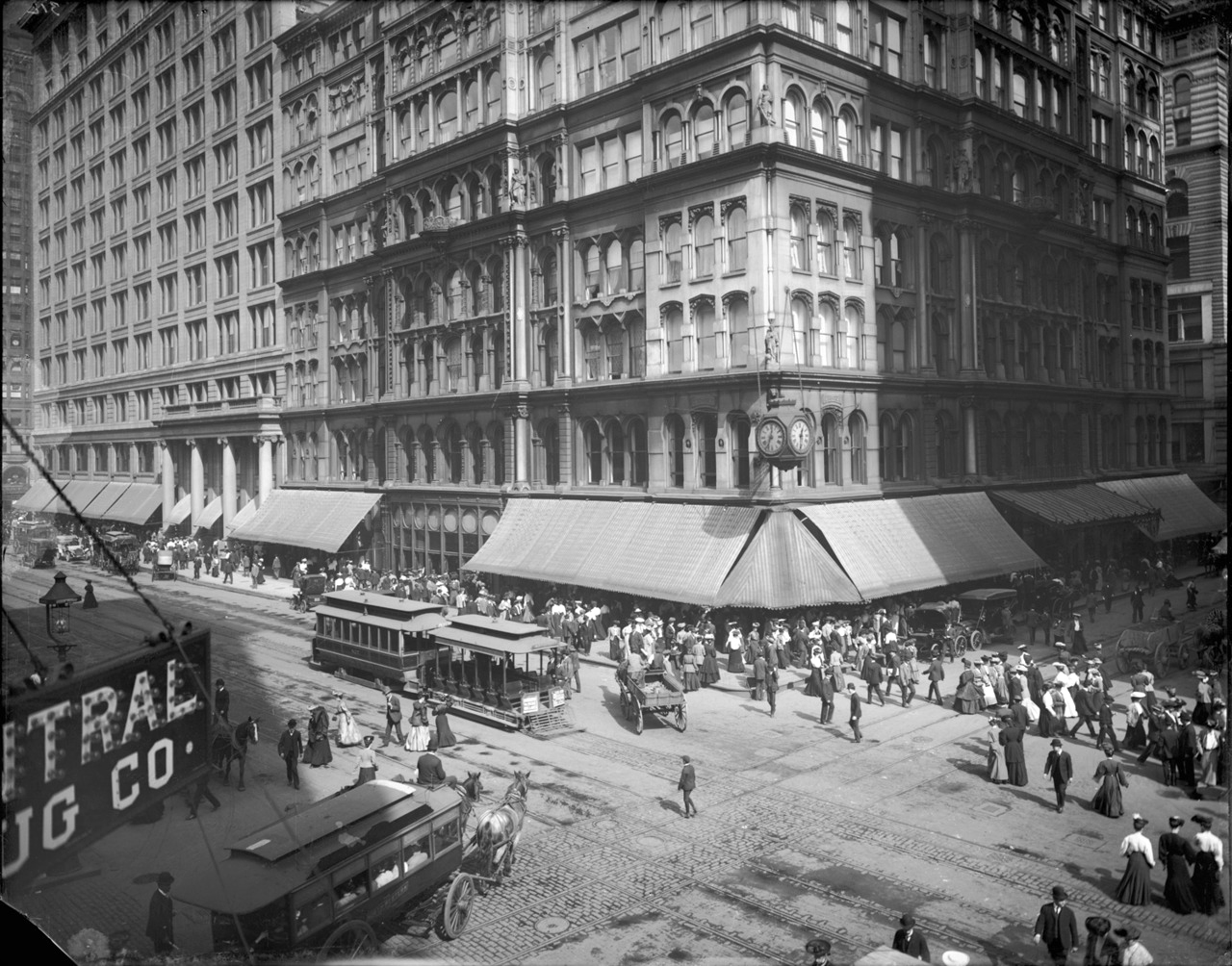
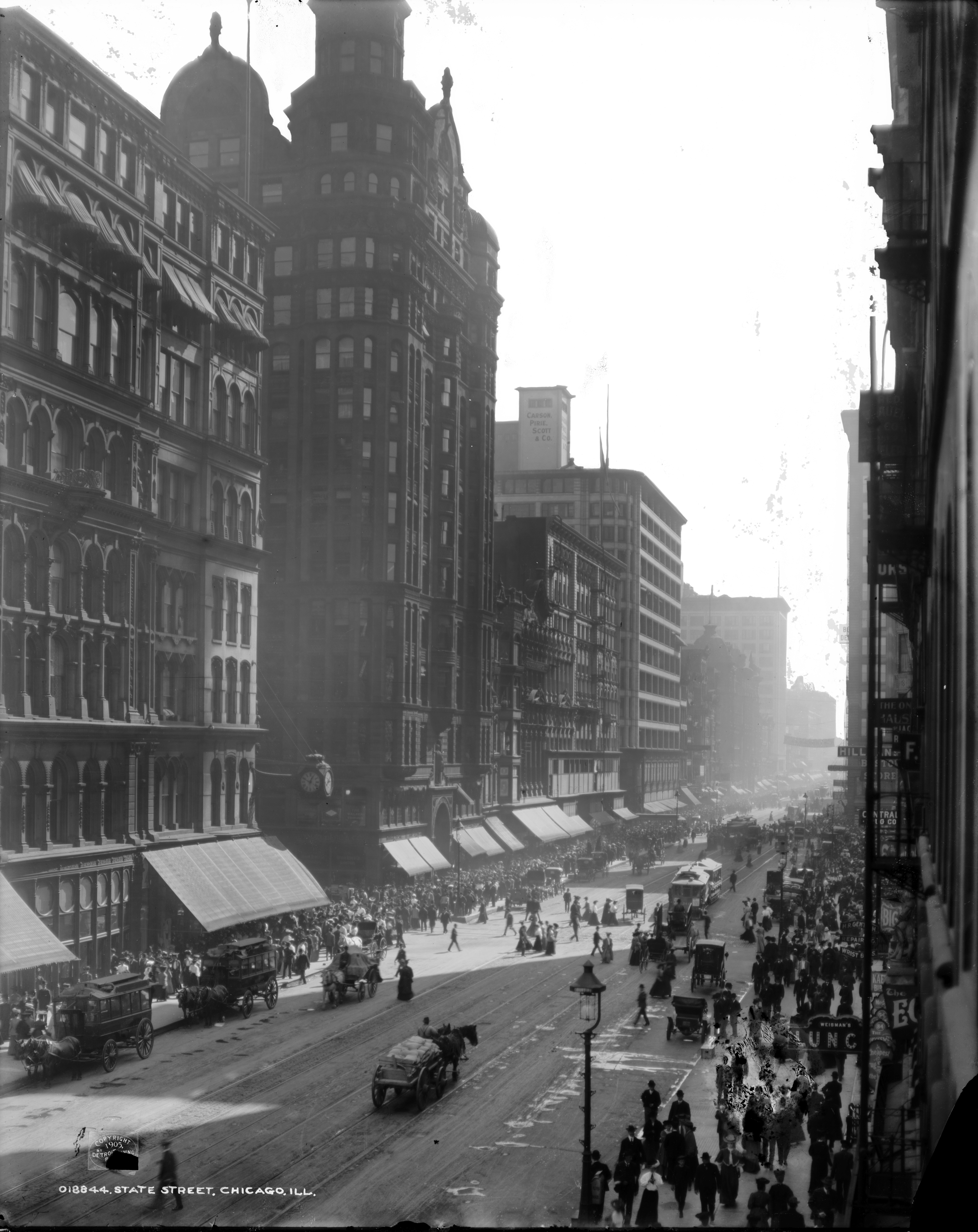
In 1902, Daniel Burnham’s 13-story Beaux-Arts building went up next door at State and Randolph; its near-identical mate to the south (replacing the second Singer Building) followed in 1907. The original Marshall Field Clock can be seen installed on this building in all three photographs.
THE EVOLUTION OF STATE & WASHINGTON
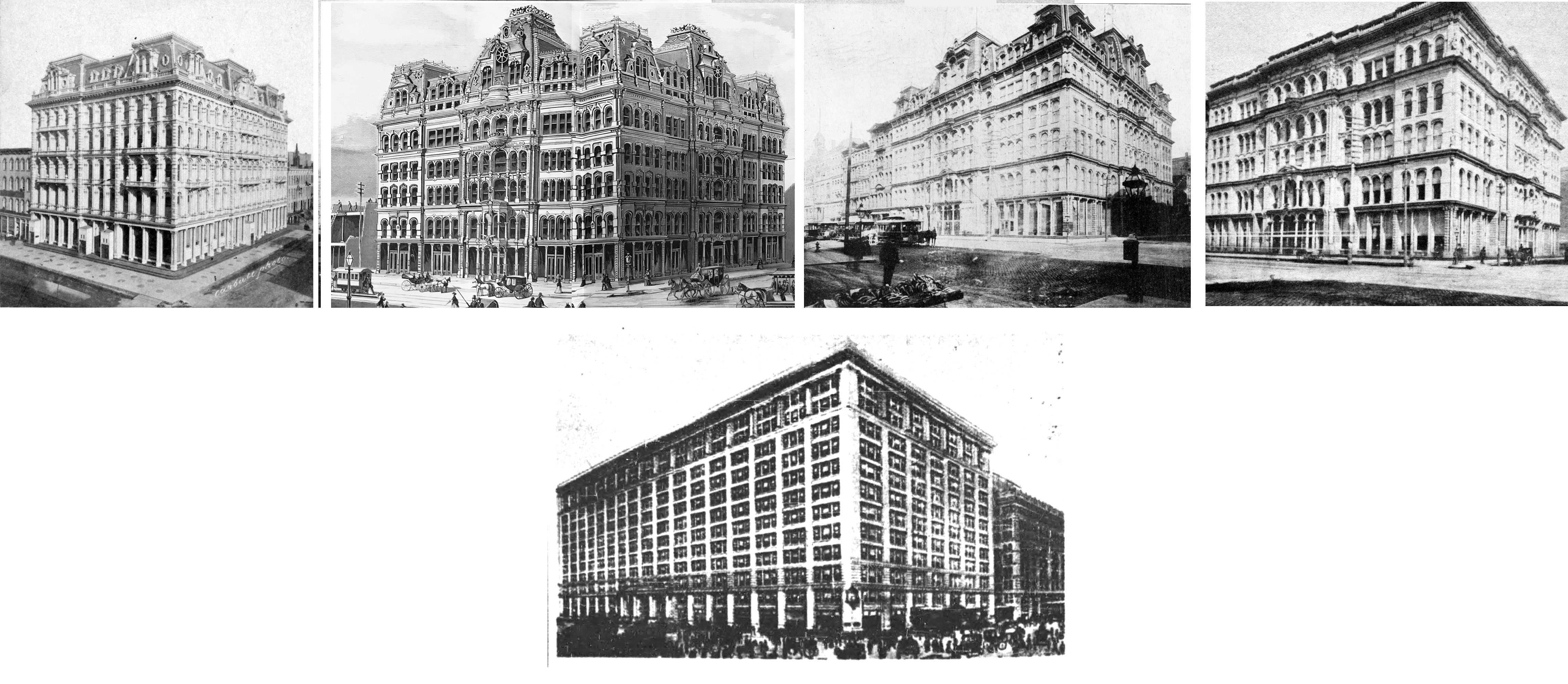
Left to Right: Field Leiter & Co. 1868-1871
Singer Building I 1873-1877
Singer Building II 1878-1905

Singer Building II
NE Corner State and Washington Streets
Robinson Fire Map
1886
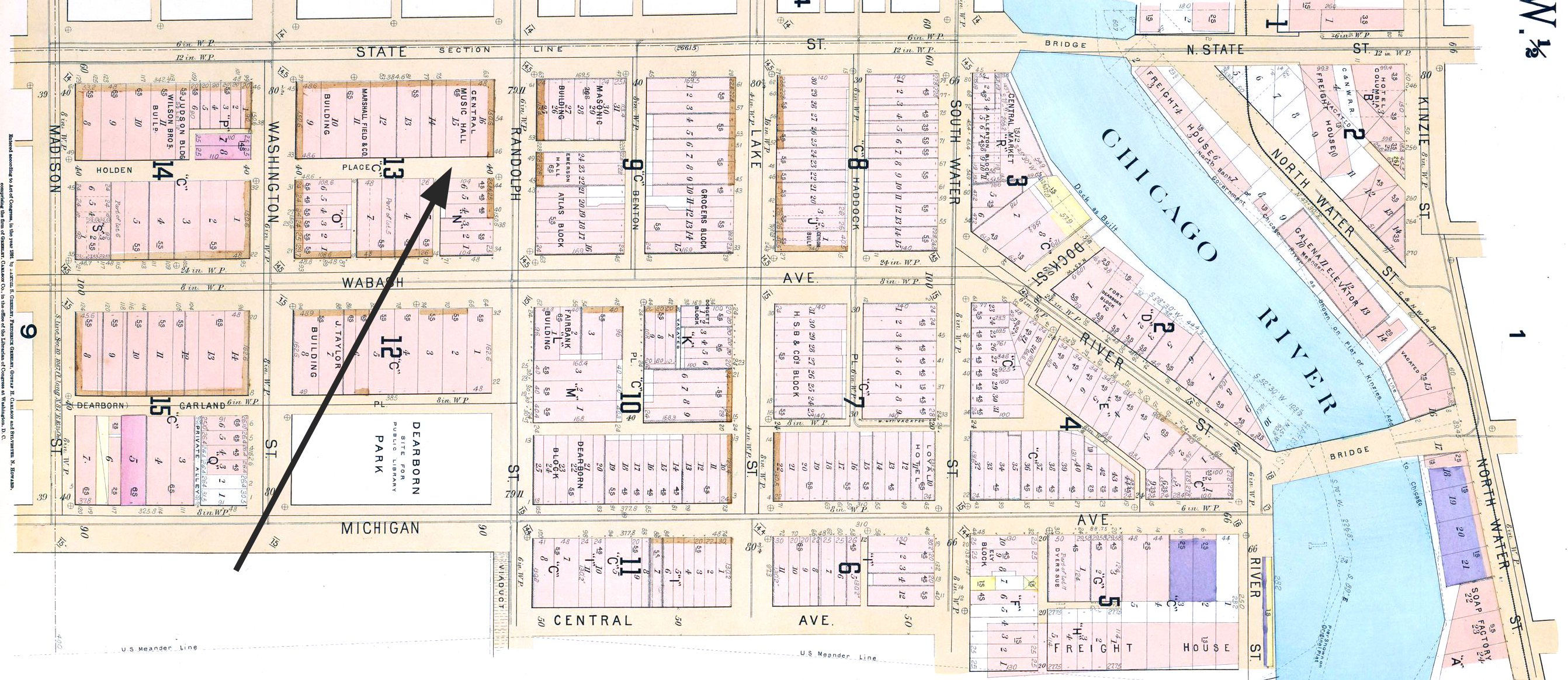
Singer Building II
NE Corner State and Washington Streets
Greeley-Carlson Atlas of Chicago
1891
Leave a Reply